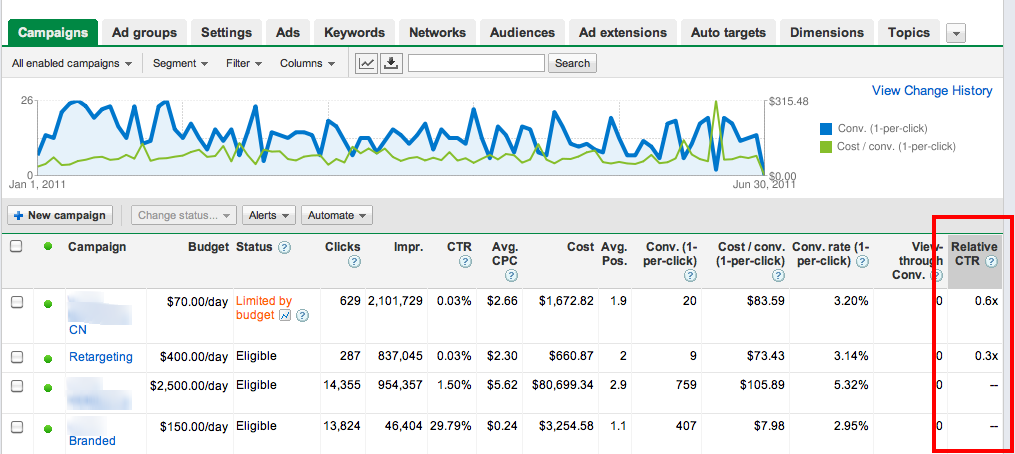I was editing my column layout in AdWords earlier this month in search of my impression share metrics, when I happened across a new little option called relative CTR. I struggled to find any information on this, as Google didn’t write about it in their blog until June 14th, but they now have a helpful article available about the new performance bundle.
Google says they introduced the relative CTR option to give you an idea of how your display ads are performing relative to the other ads that run in the same places on the Google Display Network (GDN).
To add relative CTR as a column, go to your campaign or ad group tab and click on ‘Columns.’ In the green box that opens up, simply click the Relative CTR box under the Competitive Metrics column and hit save. Your layout should look something like this:
The account above has a Display Network and Remarketing campaign running. You can see that by opting in the relative CTR column has given each of these campaigns a “score” of 0.6x and 0.3x respectively. The number is a simple calculation of the campaign’s CTR divided by the CTR of the other ads running in the same places.
(0.03%)/(x) = 0.6x
0.03/0.6 = x
x=0.05%
So the CTR of the ads running in the same places on the GDN have a CTR of 0.05%.
Obviously, if these were ads running on Google Search, the CTR would be considered extremely low, however, both of these numbers are pretty decent for the Google DN. Here’s proof of Google stating that a low CTR on the Display Network isn’t that big of a deal. Making sure that your DN campaigns are targeted to the right types of sites is still important, because the DN can spend a lot on irrelevant traffic. Our Display Network CTR above is a bit lower than the ads running in the same places, so what could we do to improve our relative CTR and make sure that the majority of our traffic is coming from the right people?
Google recommends reviewing your CPA first, because CPA is more important than Relative CTR, but there could still be room to optimize your campaign if this is the case. For the most part, the best place to start is to work on those GDN best practices.
1.) Start reviewing your placements for possible exclusions. A low relative CTR can hurt your Quality Score and result in lower ad rank on the DN.
2.) Use site and category exclusions. I especially like going to the Page Types page and choosing to opt out of error pages, parked domains, and forums when it’s obvious that the conversion rate compared to cost isn’t worth it.
3.) Revisit your message – There’s a reason why your ad is receiving less traffic than those on the same pages.
4.) Take it with a grain of salt – Remember that just because you are seeing little performance on certain sites, it doesn’t mean that you should exclude it. Advertising heels on a dress website may not receive a lot of clicks, but it’s certainly a related topic. Make sure you’re looking at your placements long term and allowing them to accumulate enough data before you exclude them, and consider the CPA above CTR.
5.) Include negative keywords in your DN campaign.
6.) Utilize contextual targeting. If you aren’t using keywords to help the AdWords system to place you on relevant sites, you might consider trying it to find additional ad groups you might not have originally thought of.





